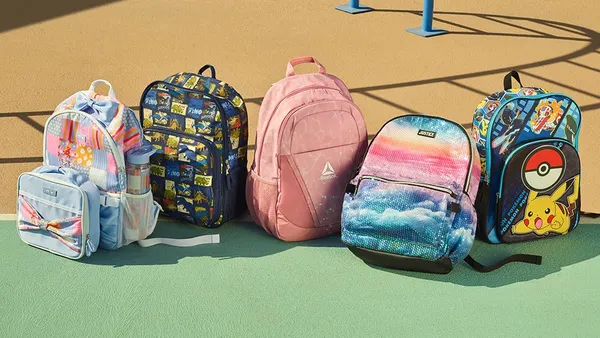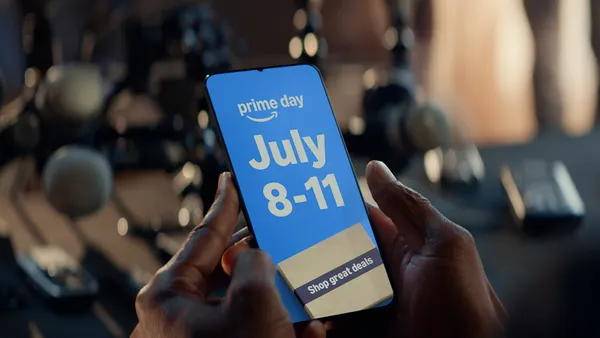Subscription services have exploded in the retail space in the past few years — from apparel services like J.C. Penney's Big and Tall subscription, Under Armour's ArmourBox and even Rent the Runway's cheaper subscription model — to more obscure finds, like the Stage Gurl subscription box for "exotic dancers," a paranormal-themed subscription service called Cryptid Crate, a coding box for kids and even a box for special effects makeup.
The future of subscription services is uncertain, though. A February study by McKinsey and Co. found that nearly 40% of subscribers ultimately cancel their service, though others see a future for the model in the convenience and value-focused millennial demographic. But that hasn't stopped retailers from jumping aboard the train — at least for now.
Here are five retailers experimenting with subscription services this year.
-
Amazon
When Amazon last year introduced its fashion box Prime Wardrobe in beta form, the stock of some major apparel retailers took a hit. Since then, plenty have speculated on the competitive threat it posed to Stitch Fix, a major try-before-you-buy fashion box pioneer.
This June, Amazon opened up Wardrobe to all Prime Members after expanding its beta test in April. The service allows customers to order three items or more with no upfront charge, and take a week to decide and pay for those they'd like to keep. Unlike box services such as Stitch Fix and Boxed, which offer periodic boxes among their menu of options, Wardrobe is not a monthly subscription, nor is it recurring. More broadly, it fits snugly into Amazon's strategy in capturing online clothing sales. According to a note from Morgan Stanley earlier this year, Prime customers are twice as likely as non-Prime shoppers to buy clothing on Amazon, which took another 1.5% of U.S. apparel market share last year.
This year, Amazon also tested a children's book box and then expanded it to all Prime members. The subscription delivers curated children's books every one, two or three months at $22.99 per box, which Amazon said reflects discounts of up to 35% off list prices, and can be geared to children 0 to 12. Amazon's portrayed the children's book box as a fun, Christmas Day-like experience for kids that fosters reading and family time. With both Prime Wardrobe and its book box, Amazon can apply its trove of consumer data and logistics network to increase its convenience proposition as well as the offerings tied to its $119-a-year Prime membership.
-
Target
In February, Target boxed up its Cat & Jack private label baby apparel for quarterly subscriptions and single orders.
Each box is priced at $40 and filled with six to seven apparel items — rompers, bodysuits, leggings and more, plus a rotating gift from the retailer — before they debut in stores. The Cat & Jack box adds to the company's existing beauty box service and a strategy that banks on the thought that customers "love convenience and discovery." On the convenience front, customers can return online or in store.
As Target continues to make significant physical and digital investments, CEO Brian Cornell told CNBC on Squawk Box near the time of the box's release, "The winning retailers of the future are going to combine great physical assets with the ease that comes along with that digital interaction," he said.
-
Boxed
In April, online wholesaler Boxed looked to reward bigger spenders through a premium service dubbed Boxed Up that offers a slew of membership perks and exclusives for $49 per year.
Members get free priority shipping on orders over $20, which a spokesperson told Retail Dive at the program's launch was its biggest differentiator, along with 2% rewards, exclusive deals and gifts, and "VIP customer service."
Jim Fosina, CEO of Fosina Marketing Group, told Retail Dive in April that "[t]he success of the Boxed Up effort is contingent on the company keeping the offering vital, exciting and engaging with their customers," including through a steady supply of value-based, subscription-based goodies regularly streaming to members. He added that, rather than snatch customers from competitors such as Amazon Prime, Boxed was likely working "to build a much stronger and sustaining base of their current customers, focused on moving 'trial' customers to subscribers, which is critically important to their overall business model.
-
Gap
Gap Inc. used 2018 to dig even deeper into the subscription game, building on previous investments in the space. In April, the company announced an addition to its BabyGap Outfit subscription box that would focus on sleepwear for kids and costs $49 a box. Dubbed BedtimeBox, the latest effort came in addition to an Old Navy subscription box launched in November of 2017, also geared toward kids, which was released just a month after the BabyGap Outfit box was announced.
According to a company blog post written by Margaret Yang, senior director of buying for Gap Kids & Baby Online, the BabyGap Outfit Box has been seeing "high retention and low return rates," which guided the company in launching the BedtimeBox extension this year. "The new BedtimeBox is another way for us to move closer to the customer, and fulfill their needs with sleepwear, which is a category we know parents need to restock constantly as their child grows," Yang wrote at the time of the launch.
For the time being, Gap Inc.'s efforts seem highly focused on the children's side of the market, a space that is becoming increasingly popular for apparel retailers trying to get into the subscription game, ostensibly because there's more need for parents to replace clothing as their kids grow up.
-
Stitch Fix
While it may seem obvious that Stitch Fix, the company widely credited with popularizing the subscription model, has continued to make moves in the space, this year has been an especially productive one for the styling service.
In addition to the company's regular offerings, Stitch Fix this year announced an expansion of its men's business and the launch of Stitch Fix Kids, as well as the introduction of Stitch Fix Extras for women — a feature that allows customers to add on essentials like bras, underwear, socks and tights to their regular shipment.
The recent moves show that the company isn't holding back on new markets, despite a disappointing first quarter report as a public company, which came in January of this year. The somewhat shaky start after the company's IPO filing got slightly better in the second quarter. The company did miss profits, but its client base also grew by 30%, and these latest efforts will likely help those numbers.
Correction: An earlier version of this story included an incomplete description of Stitch Fix. Stitch Fix offers subscription boxes along with an array of other services.














